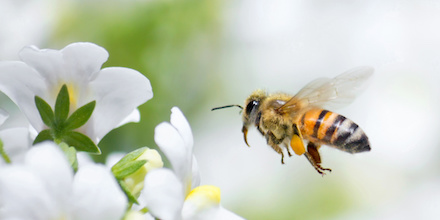
Male honeybees are born from unfertilized eggs. Female honeybees are born from fertilized eggs. Therefore males have only a mother, but females have both a mother and a father.
Take a male honeybee and graph his ancestors. Let B(n) be the number of bees at the nth level of the family tree. At the first level of the tree is our male honeybee all by himself, so B(1) = 1. At the next level of our tree is his mother, all by herself, so B(2) = 1.
Pick one of the bees at level n of the tree. If this bee is male, he has a mother at level n+1, and a grandmother and grandfather at level n+2. If this bee is female, she has a mother and father at level n+1, and one grandfather and two grandmothers at level n+2. In either case, the number of grandparents is one more than the number of parents. Therefore B(n) + B(n+1) = B(n+2).
To summarize, B(1) = B(2) = 1, and B(n) + B(n+1) = B(n+2). These are the initial conditions and recurrence relation that define the Fibonacci numbers. Therefore the number of bees at level n of the tree equals F(n), the nth Fibonacci number.
This is a more realistic demonstration of Fibonacci numbers in nature than the oft-repeated rabbit problem.

Maybe it’s more realistic, but the unrealistic rabbit model is the one
SimpsonFibonacci was thinking about.Yes, Fibonacci created an imaginary set of ideal conditions under which….
> A female rabbit will always give birth to 1 male rabbit and 1 female rabbit every month from the second month on.
This doesn’t happen in the real world. And,…
> Rabbits never die!!
> Fibonacci’s model seems to imply that brother and sisters mate!
Nice illustration of Fibonacci numbers! But also not realistic for big N — we must be counting individual ancestors more than once. Otherwise 399 generations ago there would be F(400) ancestors of one of today’s male bees. Which is more than the number of elementary particles in the universe. And it takes quite a few particles to make a bee!
Of course all of today’s bees are (more or less distant) cousins (or siblings)… In fact, they’re all our very distant cousins, too!
I would need a sentence to explain the tree building sequence. The first bee is at level 1. Now, look at the following sentence:
“If this bee is male, he has a mother at level n+1, “. Shouldn’t it bee at level n-1? I think this changes nothing but it would be the correct notation.
I like your site. The ‘Maths Montage’ mortal rabbits deals with immortality problem and is good for Fibonacci, Pell etc.
Anthony Candy, Brisbane Australia